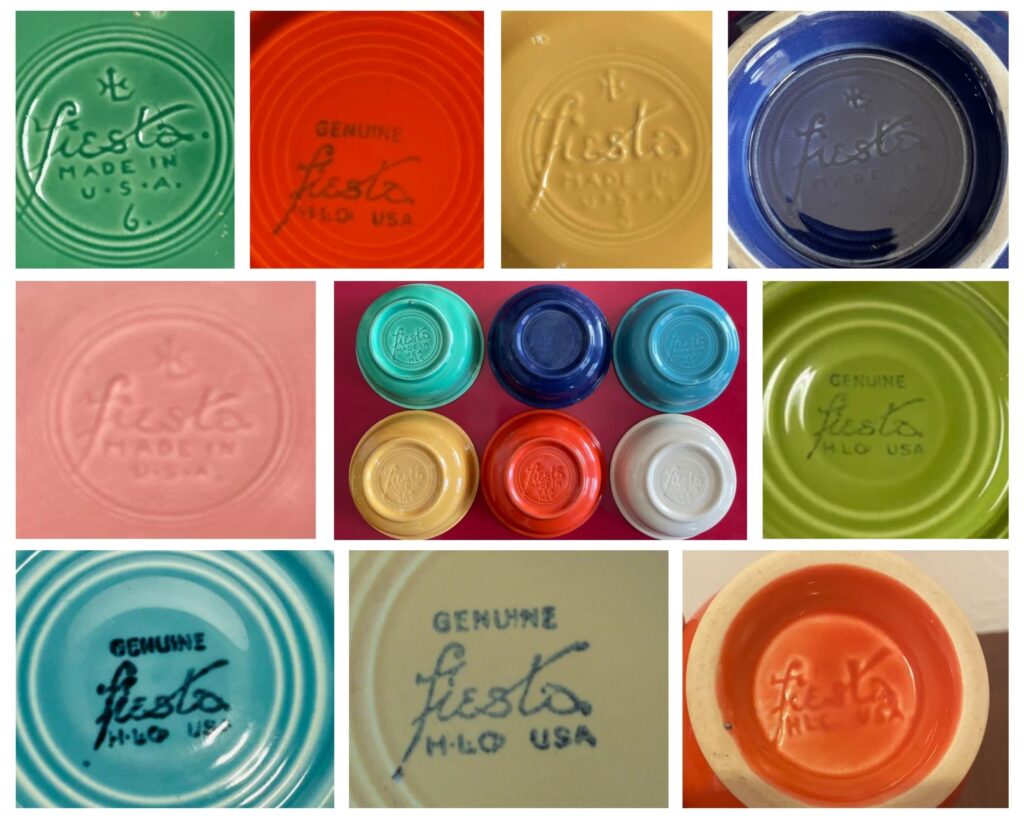
Fiestaware has become a very popular collectible in the United States china market. However, the continued production of these dinner products has made it difficult to distinguish between modern and vintage pieces.
Vintage Fiestaware includes all Fiesta items that were produced between 1936 and 1972. Collectors can identify older vintage Fiestaware by its labeling, which includes “fiesta” in lowercase letters. Modern Fiestaware includes Fiesta items made since 1986. Though there are a few exceptions, modern Fiestaware has “FIESTA” capitalized, and most pieces made after 1992 have a set of 3-4 letters marked in order to identify the production year.
The main exception is that there are some modern Fiestaware pieces that have “fiesta” marked in lowercase letters. Keep reading to learn more about identifying the age of your Fiestaware pieces.

How to Tell if It’s Vintage Fiestaware
Fiestaware is a collection of colorful fine china pieces first produced during the Great Depression. All genuine Fiestaware pieces have been made in the United States.
The simplest way to tell if your Fiestaware might be vintage (without getting into the exceptions just yet) is to look at the back or bottom of your Fiesta piece for the markings.
- Is “fiesta” marked in lowercase letters in a black ink stamp? If so, it is almost certainly vintage.
- Is “fiesta” marked in lowercase letters in an imprinted in-mold marking? If so, it is probably vintage, IF it is in a vintage (pre-1973) color: red, cobalt blue, light green, yellow, turquoise, old ivory, forest green, rose, chartreuse, gray, medium green, antique gold, turf green.
It is actually probably easier to determine whether your Fiestaware is modern, meaning it has been produced since 1986.
- Is “FIESTA” capitalized? It is a modern piece, definitely NOT vintage.
- Is the Fiesta logo in a circular pattern? It is a modern piece, definitely NOT vintage.
- Is there a single “H” below the “fiesta” imprinted in-mold logo? It is a modern piece, definitely NOT vintage.

Keep reading for example images of Fiesta markings, as well as more detailed information on determining how old your Fiestaware is.
Ink Back Stamp versus Impressed In-Mold Marking
There are two types of back stamps or markings that could be on your Fiestaware. This is true for both vintage and modern pieces.
The first type of Fiestaware marking is an ink stamp, which is basically a black logo stamp that was placed beneath the glaze. The second is an in-mold impressed marking that would be pressed or imprinted into the piece itself. See the difference in the photos below.

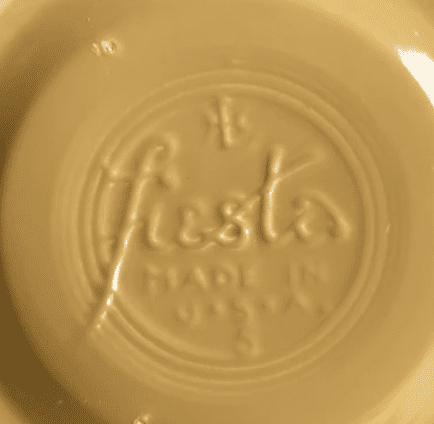
Vintage Fiestaware markings will always have “fiesta” in lowercase letters. However, there are a few modern post-1986 pieces that also have the lowercase “fiesta” imprinted in-mold markings. The lowercase “fiesta” marking in and of itself does not necessarily mean that you have a vintage piece, UNLESS it is an ink-stamped marking.
If it is an imprinted in-mold marking with a lowercase “fiesta”, then it could either be a vintage or modern Fiestaware item. The reason that some modern post-1986 Fiestaware pieces have the lowercase “fiesta” marking is that the original vintage Fiesta molds were used for certain modern pieces.
As an example, see below this Fiestaware disc pitcher in the color apricot, which is a modern color produced between 1986 and 1998. However, you will note that it is an imprinted in-mold logo that is the original, vintage lowercase “fiesta” marking. Be aware that just because your “fiesta” imprinted marking is all lowercase DOES NOT mean that your Fiestaware item is vintage (pre-1973).

As you can see, this makes it difficult to date Fiesta items and can cause some confusion among Fiestaware collectors. To help prevent confusion over modern versus vintage Fiesta pieces, an “H” marking was added around 1997 or 1998 on some (but not all) imprinted in-mold Fiestaware pieces. If there is a single “H” below a Fiestaware imprinted marking, then the piece is definitely new and not vintage.
However, this continues to be frustrating for collectors, because a Fiestaware imprinted or embossed piece that doesn’t have the “H” still does not necessarily mean it is a vintage piece. Both images below are modern Fiestaware pieces produced after 1986 that have the lowercase “fiesta” markings from the mold imprint, one with the “H” and the other without it.
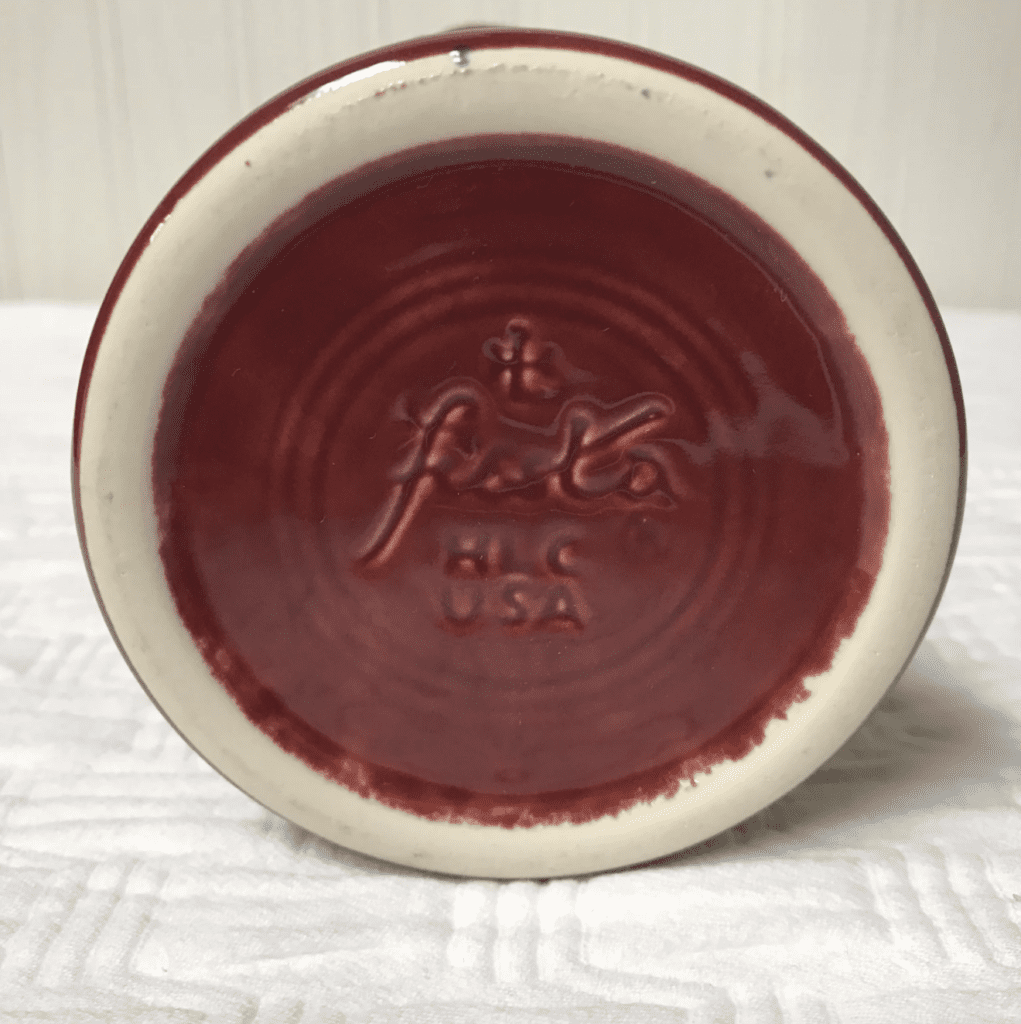
Now that we have defined the exceptions to the lowercase “fiesta” markings, let’s continue to discuss identifying and dating your Fiestaware piece.
How to Date Fiestaware
On vintage Fiestaware that is ink stamped, you will likely find the word “GENUINE” printed in all caps above the all-lowercase “fiesta”. Below the “GENUINE fiesta” markings, you will usually see HLC, where the “C” is actually a small “Co” that often appears blurred together. These stand for the company’s original name, the Homer Laughlin China Company. Lastly, you’ll see “USA”. See below for examples of the vintage pre-1973 Fiestaware ink stamp markings.
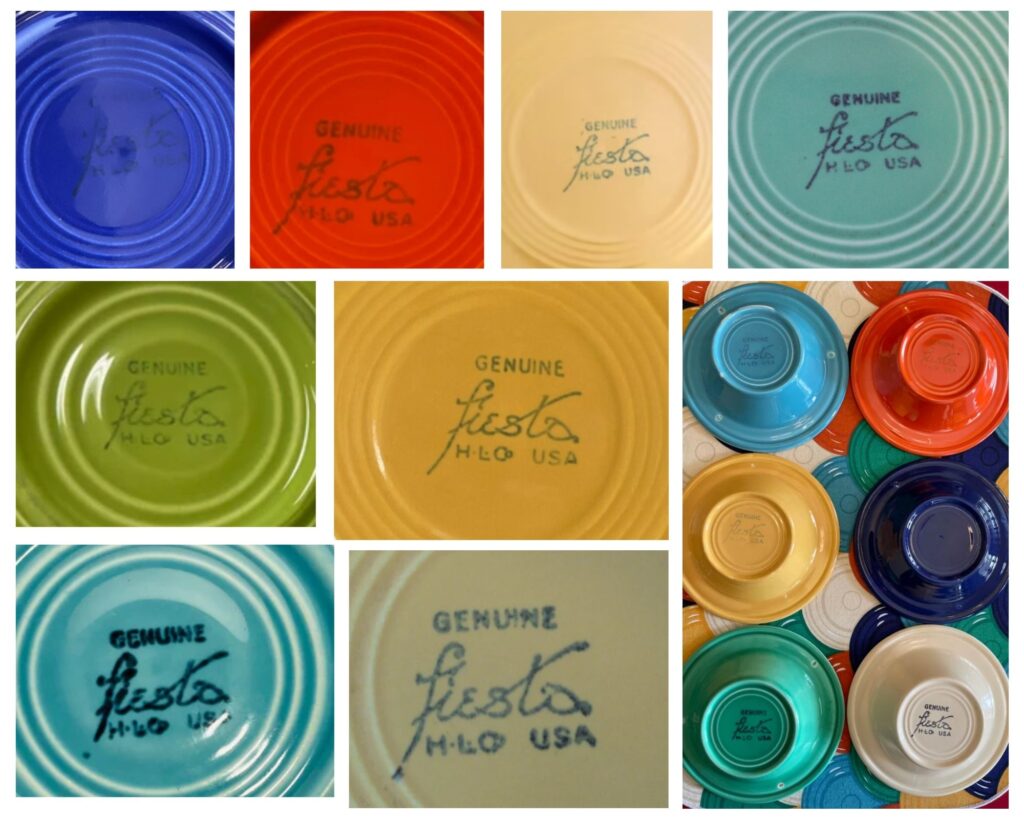
If it is a vintage Fiesta piece that uses the in-mold imprinted logo, then it probably does not have the word “GENUINE” on it. It will usually say “MADE IN USA” or possibly “HLC USA”. See below examples of vintage pre-1973 in-mold imprinted Fiestaware markings.
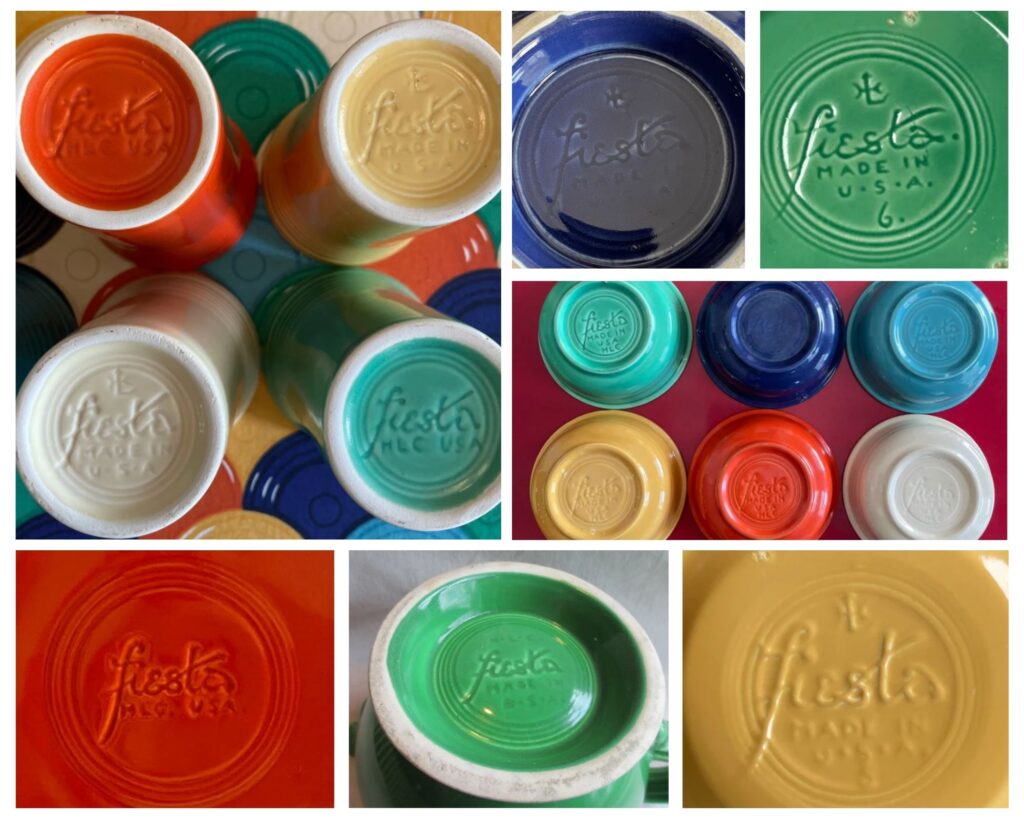
Unfortunately, not every vintage Fiesta piece has a marking on the bottom. These pieces will be a bit more difficult to identify. In general, Fiestaware would only be unmarked for certain items where either the stamp couldn’t fit, or the design of the item prevented a mark from being possible, such as juice tumblers, demitasse cups, teacups, salt and pepper shakers, sweets comports (compotes), and egg cups.
Another way to help identify vintage Fiestaware is by its color. The original Fiestaware colors are red (often called radioactive red), yellow, light green, cobalt blue, turquoise, and old ivory.

Here is a list of all of the vintage Fiestaware colors produced before 1973: red, cobalt blue, light green, yellow, turquoise, old ivory, forest green, rose, chartreuse, gray, medium green, antique gold, turf green.
Please note that turquoise, yellow, cobalt blue, and rose Fiestaware pieces have been produced again since 1986, so look at the markings on the bottom to determine if your Fiesta is the original vintage run of those colors from the 1930s-1970s, or if it’s a modern post-1986 production.

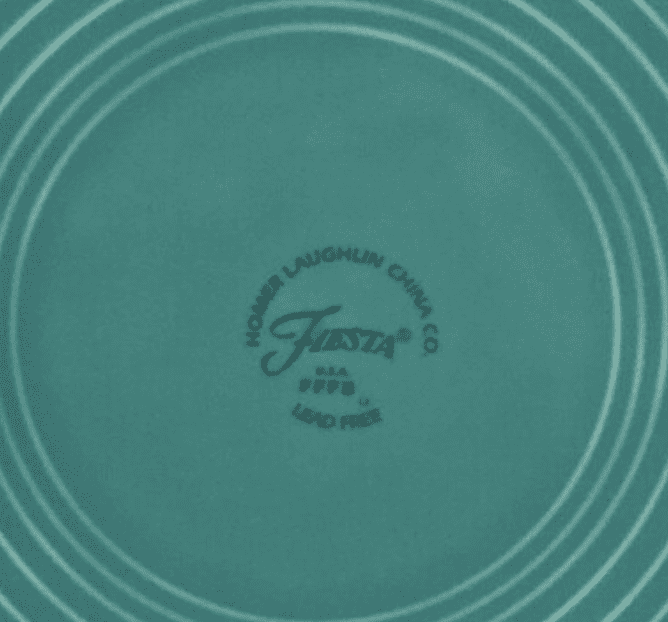
It can be a bit tricky determining what color your Fiestaware piece is. For example, there are multiple Fiestaware greens, and certain colors are often hard to tell apart, such as the 1990s limited edition sapphire blue and the original cobalt blue.
To determine the exact color of your Fiesta, you can look at images in our Fiestaware color guide, or check out reputable Fiestaware dealers on Etsy for images to compare your piece with, such as JessiesVintageDishes or TheSellersCabinet.
What Does a Round or Circular Fiestaware Logo Marking Mean?
If a Fiestaware piece has the logo marked on the bottom in a circular or round pattern, then it is a newer Fiesta item, NOT a vintage piece.

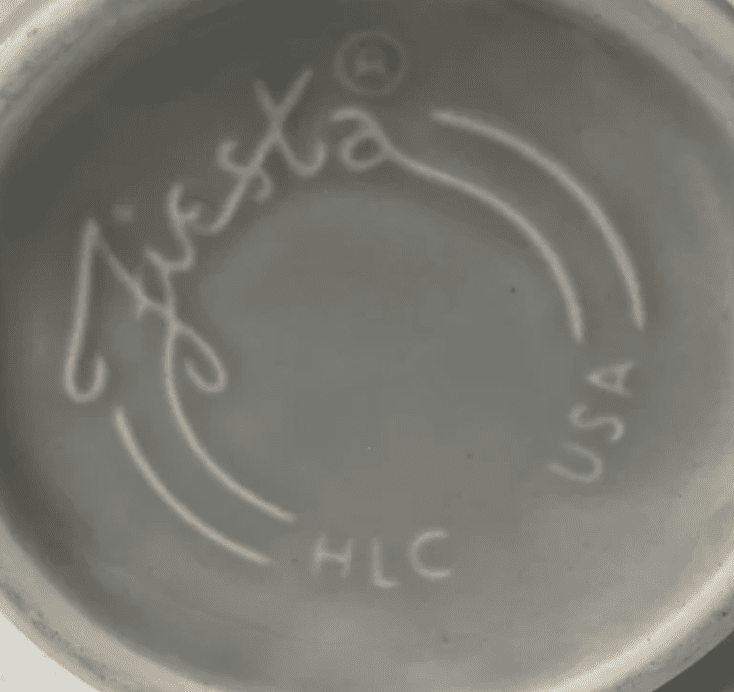
As you can see, there is not a quick and easy way to determine if your Fiestaware is vintage based on the marking alone. However, if you’ve determined that you do have a vintage piece, then you can use the manufacturing color guide to help you determine the date range that your Fiesta was produced.
Once you’ve determined whether or not your Fiestaware is vintage or not, you can look into valuing your vintage Fiesta.
Letter Patterns for Identifying and Dating Post-1980s Fiestaware
In general, Fiestaware dishes produced after 1992 have a letter pattern on the bottom of them. The Homer Laughlin China Company uses these to identify the year of production. They also usually have the words “LEAD FREE”.
Genuine Fiestaware continues to use this letter system. In other words, pieces made before the 1990s will not have this letter system, and identifying their exact year of production will be next to impossible.

Let’s look at the letter patterns used for later years to help you identify your Fiestaware pieces.
- 1992 – GG
- 1993 – HH
- 1994 – II
This pattern continues until 2011 when the code ZZ was used. After this point, the company began using a three-letter code to label the piece’s production year.
- 2012 – AAA
- 2013 – BBB
- 2014 – CCC
This will continue until 2036, at which point, Fiestaware will require a new coding system.
In addition to the 2 or 3 letters identifying the production year, another letter was used to distinguish what time of year it was made. Pieces made between January and March have an extra A after the year code, those made between April and June a B, July through September a C, and October through December a D.
Therefore, if your Fiestaware item has three letters total, then it was made before 2012, but if it has four letters, it was made after 2012.
Using these letter codes is the best way to identify the year your modern Fiestaware pieces were made.
If you have a piece of modern Fiestaware that is using an imprinted in-mold logo, and therefore does not include the letter system identification, then your best bet at dating your Fiesta will be to determine the color of your piece and then check it against the manufacturing color history.
Which Fiestaware is Safe to Use?
Now that you’ve determined the age of your Fiestaware, you may want to find out if it’s safe to eat off of. Vintage Fiestaware did contain uranium, and some colors are considered radioactive.
In addition to uranium, your vintage (pre-1973) Fiesta probably had some trace amounts of lead. According to the Fiesta factory, their dinnerware products have been “lead-free” since 1986. However, they only became certified lead-free in 1992.
For more information, check out our full article on Fiestaware and Safety.



